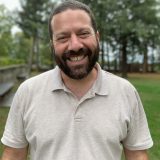“Do not curse the Deaf nor put a stumbling block in front of the blind” (Leviticus 19:14).
Like all of us, I hold many identities. I am a Jew, a father, a Grateful Dead fan, a photographer, an educator. I am also Deaf.
The Jewish community is where I am most at home. Some of my earliest childhood memories are of going to temple on Shabbat mornings with my family (and sneaking cookies from the kiddush). In elementary school, I found comfort and community with Our Way, an organization serving Deaf Jewish children and adults. In middle and high school, United Synagogue Youth (USY) was the center of my social world. I have been a proud, dedicated Jewish communal professional for two decades.
I have also experienced deep isolation from my beloved Jewish community due to my disability. As a child, I was denied access to Jewish day school because I was Deaf. I struggled through Hebrew school because of my well-meaning teachers’ lack of experience educating children with hearing loss, and the school’s unwillingness to provide an aide. In countless Jewish settings, I have been denied full access to information and content, and the reasons given are always the same: interpreters are costly, captioning feels inconvenient, and nobody else would benefit from accommodation.
The pandemic has exacerbated existing feelings of exclusion. All of us have experienced loneliness, stress, and exhaustion over the last two years. We have missed out on time with loved ones, readjusted our work and home lives, and redefined normalcy time and time again. We have taken measures to protect ourselves and the people we love by wearing masks and honoring social distancing. We have all struggled.
For those of us who are Deaf and hard of hearing, the pandemic has been devastating. All Deaf individuals are unique. I personally wear two hearing aids to amplify sound, and I rely heavily on lip reading to fully communicate with others. With ubiquitous mask-wearing, lip reading is impossible, voices are muffled, and it is incredibly difficult for me to understand what others are saying—particularly children, around whom I am surrounded all day in my work.
Everyday tasks that I used to complete independently—including grocery shopping and ordering a cup of coffee—now require me to seek assistance from my partner or kids in order to make sense of the incomprehensible sounds. At the end of each day, I am exhausted from straining to hear and attempting to put fragmented pieces of noise together.
In the last three to five years, our Jewish community has reckoned with our obligation to engage with diversity, equity, inclusion, and justice (DEIJ) work. It is essential that we commit ourselves fully to cultivating communities of belonging and radical inclusion for all people. Yet, too often, people with disabilities are left out of this critical work, despite the fact that the term “inclusion” was originally utilized in the context of the disability community. Our Jewish community’s commitment to DEIJ must include individuals with disabilities.
This JDAIM (Jewish Disability Awareness, Acceptance and Inclusion Month), I urge our Jewish community to shema, to hear—and truly listen to—the needs of those with disabilities, and to take action to make our Jewish community more inclusive, accessible, and comfortable for all people. Our entire community—and the whole world—benefits when everyone is included.
I invite you to consider utilizing the following tips to make your Jewish space more accessible—and I encourage you to develop your own that fit your unique community, in consultation with experts in the field and members of your community with disabilities.
- When you are hosting an in-person event, offer a sign language interpreter. If masks are required, provide clear masks to presenters and participants.
- When you are gathering people online, use a platform that offers closed captions, and be sure they are turned on prior to the start of the event. Captioning is useful for everyone, not only for individuals who are Deaf and hard of hearing.
- When you are creating marketing or promotional videos for your organization, caption your content. (Pro tip: This also helps people who are scrolling through social media in public places, as they don’t need to turn up the sound!)
- Be an ally. If you learn ways of making your space more accessible for people with disabilities, share them with other leaders in your community.
- If they are open to discussing their experiences, consult with your community members with disabilities. Stay humble and open—and remember that what works for one person or community might not work for others. Be willing to listen, learn, make mistakes, and practice resilience in the quest for full inclusion.
- Seek to hire more individuals with disabilities. The unemployment rates in the disability community are staggeringly high, hovering somewhere around 80%, according to the U.S. Bureau of Labor Statistics. Create hiring practices that make it clear that individuals with disabilities are welcome in your community.
- When in doubt, hire a disability inclusion specialist to perform an audit of your facility, organization, or event. These experts can help to ensure that your community is utilizing best practices of inclusion.
JDAIM may be only a month long, but for those of us living with a disability, the journey toward acceptance, awareness, and full inclusion is lifelong. Let’s work together to ensure that our Jewish community is accessible and inclusive for all individuals, regardless of ability.
This post has been contributed by a third party. The opinions, facts and any media content are presented solely by the author, and JewishBoston assumes no responsibility for them. Want to add your voice to the conversation? Publish your own post here. MORE



